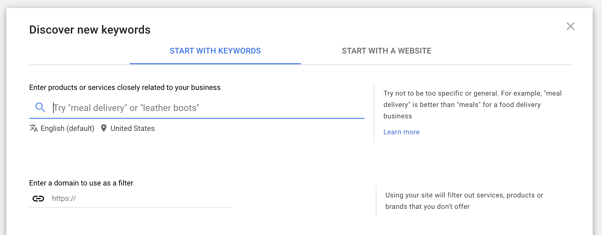Spend any amount of time reading about SEO, and you’re bound to stumble across one or more articles extolling the virtues of niche keyword research – and with good reason too.

Finding the right keywords is often key to getting a good return on investment (or ROI) from your SEO campaign. Assuming that you're selling to a niche audiance with specific behaviours, preferences and interests, there's little or no chance that you'll be able to zero in on the language they're using by guessing - or making assumptions based on your own experience
That's not us being mean by the way. It's something backed by hard data. (source: SEMRush).
Instead of guessing, you'll need to spend time and effort working out how they search; what sort of terminology they know/use, and how their search behaviour changes as they move through the B2B buying journey, and become more informed about the product/service you're offering.
Niche keyword research is your way of finding out what your audiance really care about, and how you can go about reaching them with engaging blog posts, articles, landing pages or guides.
It guides your content strategy, it helps you build a clear understanding of the landscape you’re operating in and it makes sure that you’re putting the work into content that’ll actually grow your organic search rankings. But the “careful and considered” part is key here.
In a way then, niche keyword research is a bit like cooking a bolognese sauce – in the sense that the quality of the final product is directly proportional to the amount of time and effort you invest in the project.
Niche Keyword Research Takes Time
Digital marketers who rush their niche keyword research often end up optimising their content for phrases that matter to them – instead of the people they're trying to turn into customers.  It’s all too easy to assume that you know what people are searching for, and pour time and effort into pillar or landing pages that are fundamentally incapable of landing in front of your target audience because they’re optimised for phrases that nobody actually uses.
It’s all too easy to assume that you know what people are searching for, and pour time and effort into pillar or landing pages that are fundamentally incapable of landing in front of your target audience because they’re optimised for phrases that nobody actually uses.
Content that’s “dead on arrival” as paramedics would say.
If you need a good example of that all-too common mistake, you need look no further than the Lush website. There’s a lot going on here, but it’s their vegan pages that we want to focus on. Someone’s obviously spent a lot of time creating specialised landing pages to help Lush attract new customers with a specific interest in vegan cosmetics.
Thing is, they’ve optimised the pages for keywords that people just don’t use. Their page for vegan haircare is a good example: Elements like the title tag, page content and h1 tags are all optimised for the phrase “vegan hair products”
But “vegan hair products” is only Googled 2,400 times a month.
Meanwhile “vegan shampoo” is Googled approximately 12,400 times a month, but the current page stands no real chance of ranking for that phrase because it’s too busy chasing a keyword with 1/3rd of the search volume.
At 3,600 average monthly searches, even “vegan shampoo and conditioner” would have been a better fit than “vegan hair products”. But the sad reality is that Lush - like so many brands - skimped on their niche keyword research, made assumptions about their audiance, targeted the wrong phrase and nosedived their potential growth in favour of a phrase that made sense to industry insiders instead of the brands target audience.
Of course, this example raises several important questions: How are you actually supposed to do niche keyword research? What does it take to avoid these mistakes, and how am I supposed to start building a thorough understanding of the language my audience is using to search for products or services like mine?
To help you answer these questions, we’ve put together a painless guide to niche keyword research – using plain english to explain our own process, dispel some common myths and show you how to zero in on the phrases that’ll drive prospective customers to your website.
Start With The Most Obvious Keywords In Your Niche
Niche keyword research is best done with the help of automated tools like Google’s Keyword Planner, SEMRush or Ahrefs.
These tools track and record monthly search volumes for millions of different keywords, and they’re smart enough to suggest useful or related keywords to help guide your efforts but you still need a starting point: A handful of keywords that you can feed these tools to point them in the right direction. To find these niche keywords, log into Google' Keyword Planner (this is a free tool, and worth its weight in gold). Pick ‘find new keywords’ and you’ll be prompted to input a few search terms that relate to your core products or services.
To find these niche keywords, log into Google' Keyword Planner (this is a free tool, and worth its weight in gold). Pick ‘find new keywords’ and you’ll be prompted to input a few search terms that relate to your core products or services.

So to get things moving, try brainstorming five or six phrases that people are probably using to (try and) find your products or services. These don’t have to be correct. In fact, you’ll probably find that you’ve got them completely wrong but you’ve got to start somewhere and the automated tools we’re using here will quickly correct any mistakes.
Once you’ve got your list of ‘starter’ keywords, you can start plugging them into one or more of the following keyword tools:
Free Or Paid Keyword Tools That’ll Get The Ball Rolling
- Moz Keyword Explorer - This tool provides reliable search data for millions of searches. It’s free for your first 10 queries, but requires a subscription after that.
- SEMRush - The ultimate SEO tool, and a fantastic platform for keyword research. It requires a subscription but provides in-depth competitive metrics that are very useful (more on this later!)
- Google Keyword Planner - Google’s own keyword research tool. Provides accurate search volumes for countless phrases if you are an Adwords customer, but results are obscufated for people who aren’t paying Google to run ads.
- RankIQ - a simple and straightforward keyword research tool that uses an AI algorithm to provide keyword recommendations. Less granular than the other options listed here, but useful if you’re in a rush and want accessible data.
- Ask The Public - This tool doesn’t provide search volumes, but it does provide useful information about related search terms, including some of the ‘long tail’ or less popular, more specific phrases real people use when browsing a particular topic.
You can take the suggestions from Ask The Public and type them into SEMRush or Keyword Planner for the search volume data we’ll need to compile our keyword list. - Seed Keywords - A ‘human intelligence’ tool that leverages your network to provide real-world keyword suggestions in much the same vein as Ask The Public.
When you type a keyword into Keyword Explorer, SEMRush or Keyword Planner, they’ll spit out a list of related search terms, alongside information about the number of times they’re searched per month, their competitiveness and rough approximation of the amount of work needed to rank a page for them.
This data may feel fairly meaningless right now, but it’ll be key to building that list of high-value, niche keywords we talked about earlier.
In fact, the results pages provided by tools like SEMRush and Google Keyword Planner provide all the information you need to build an absolutely bulletproof keyword and content strategy but it is important to understand how to analyse the data they provide.
Metrics like “competitiveness” seem relatively self-explanatory, but they can be misleading and often lead you down the wrong track.
It’s also important to note that the data provided by keyword research tools is rarely 100% accurate. Type the same “seed phrase” or starting keyword into SEMRush and Moz Keyword Explorer and there’s a good chance both tools will spit out wildly divergent data.
There are a few reasons for this - different tools have access to different data sets, some browsers like chrome obscure data for third party platforms and keyword tools are notoriously unreliable when it comes to collating data on low volume keyword searches.
But that’s not hugely important here. Using one or more keyword research tools will still provide you with a rough approximation of the relative popularity of various phrases, and that’s all we really need for now.
Once you’ve entered your seed keywords into the tool of your choice, download or copy/paste the results into a spreadsheet and we’ll get to work analysing the best targets for your future content campaign.
Don’t Get Too Hung Up On Search Volume
It’s important to point out that niche keyword research isn’t just about finding a big old list of high-volume keywords that you want to rank for Fundamentally, the purpose of any niche keyword research project is to hone in on keywords that are:
Fundamentally, the purpose of any niche keyword research project is to hone in on keywords that are:
- Relevant for your business
- Used by your target audience (the target bit is key here)
- Indicative of someone who’s actively looking for products (or services) you offer
And this last point is key (pun fully intended). After all, there’s no benefit to ranking for a keyword that drives dozens of research students to your site, or precipitates a sudden influx of enquiries from people who clearly have no intention of actually engaging with your offering.
Instead, we want to pick keywords that people are actually using when they’re moving through the so-called “buying journey”. Which is to say ‘actively looking to learn more about a given service or product, refine their search for the same, or find a provider capable of supplying knowledge insight or guidance about a something they need’
To do this, we’ll need to weigh up quantitative data - like search volumes and competitiveness - against qualitative data about intent and audience so that you can zero in on keywords that are actually being used by the people you want to target.
In other words, we’ll be trying to go beyond the simple, surface metrics surrounding popularity and locate the phrases that’ll actually drive customers to your site.
As an example, let’s try typing ‘digital marketing’ into Google’s Keyword planner, so that we can start looking for some valuable keywords.
At first glance, “digital marketing” looks like the obvious keyword to target here: It’s searched for some 22,100 times a month. And that’s just in the UK.
But it’s important to remember that there are many, many reasons to Google something vague and generic like ‘digital marketing’.
20% of those 22,100 people could be high school students, tasked with defining the term for an essay or test question, 10% could be people looking for digital marketing jobs and another 10-20% could easily be competitors Googling the phrase to see who’s currently ranking number one for their favourite vanity keyword.
Truth be told, time spent capturing that traffic would be time wasted, especially when you look at other, slightly less-trafficked niche keywords like “digital marketing services” which show much more intent to buy.
Analysing Niche Keyword Intent
And that brings us neatly to our next point: How are you supposed to measure the intent behind a keyword, or work out which phrases are being used by people who are actually primed to engage with your offering?  Common sense is a good guide: If you spend any amount of time looking at (and thinking about) a keyword list, you’ll notice that some phrases start to leap out at you: Phrases that betray an interest in - and knowledge about - your area of expertise that are generally indicative of someone who’s positioned to make a purchase.
Common sense is a good guide: If you spend any amount of time looking at (and thinking about) a keyword list, you’ll notice that some phrases start to leap out at you: Phrases that betray an interest in - and knowledge about - your area of expertise that are generally indicative of someone who’s positioned to make a purchase.
You can also keep an eye out for so-called “intent signifiers”. These are words like “which”, “buy”, “best” “vs.” “cost” or “how”, which are often used by people who are in the process of buying a product or service. (Source: AgencyAnalytics)
Some people also recommend using Keyword Planner to establish commercial intent; downloading a spreadsheet full of suggestions and combing through them to find examples with a higher-than-average PPC bid prices – The logic being that people are competing on these keywords because they drive a lot of value.
But that’s its own can of worms because highly-competitive keywords - targeted by a lot of advertisers - often see organic search results pushed way down to the bottom of the page so there’s more space for paid ads.
If you want to be really clever, you can even try your hand at ‘reading the SERPs’ or looking at the search results page returned for a particular query to try and work out whether there’s commercial intent behind it.
Google have spent a lot of time and money working out ways to anticipate the intent behind a given search, and while they may not get it right 100% of the time, they are generally pretty close to the mark.
If you Google something like “choosing the right shoe”, you’ll notice that the top of the page is dominated by shoppable ads, and Google’s search filters have been tweaked so that “shopping” comes right after “all results”.
Search for “types of shoe” and you’ll see the opposite: The top of the page is occupied by an organic listing (Wikipedia) and “images” is now the second default filter.
Clearly, Google thinks “choosing the right shoe” has more commercial intent than “types of shoe”, hence the shoppable search results and focus on transactional elements.
Looking out for similar signs can help you spot the opportunities that are most likely to drive paying traffic to your site, and you may find it helpful to run a quick search for any questionable niche keywords: Just to see if Google can give you a steer on their relative value.
But in the interests of total transparency, we’ll be the first to admit that there is no surefire way to measure the intent behind a keyword – niche or otherwise. You can make educated guesses, but there are so many variables at play here, and no one method will prove totally foolproof.
Imagine you’re selling premium toasters, made by a company that employs skilled artisans from the French Riviera. You could spend forever identifying all the “what’s the best toaster” type keywords; optimise content for them and push it live only to find that people who compare toasters are almost always motivated by price and rarely buy luxury goods.
Similarly, you could overlook or dismiss a keyword like “best green toasters”, only to find that the people searching for green toasters almost always slot into the upper-middle class demographic you’re keen to target.
But if you apply a liberal dose of common sense, keep an eye out for interesting opportunities and spend some time evaluating the possible intent behind some target keywords, you should find that you start to build a list of phrases that feel right, and that’s where you’ll want to spend most of your time.
Generally speaking, we find that our initial list of 100-200 potential niche keywords is quickly winnowed down to a list of 30-50 target phrases that are really worth chasing, and there’s nothing wrong with that.
Creating good content takes time. Creating rankable content takes even longer and the last thing you want to do is bog yourself down with a long list of target keywords that obscures the real gems, and distracts you from high-value work.
Are Your Niche Keywords Too Competitive?
Having assembled a list of target keywords that seems to be
- Popular
- Relevant
- High-intent
You’ll probably be itching to race off and start creating content, but it’s well worth taking a few moments to check how competitive your chosen phrases are meant to be. Now, I want to caveat this section by pointing out that “competitiveness” (as expressed by programmes like Adwords, SEMRush or Ahrefs) has always been a contentious metric. Every platform has its own (proprietary) formula for calculating competition, results are never expressed in the same way and you can tie yourself in knots trying to figure out whether
Every platform has its own (proprietary) formula for calculating competition, results are never expressed in the same way and you can tie yourself in knots trying to figure out whether
But in principle, the idea of measuring competitiveness is a sound one: Search engines like Google will always try to rank the best possible content for a given query, and knowing whether you’re up against mom and pop businesses, multinational companies or major news sites can be a tremendous help when you’re trying to work out whether it’s worth going after a given keyword.
Not that we’re saying that you should avoid popular or highly-competitive niche keywords. If your content is good and you optimise a page well, you can often outrank entrenched websites and bring in a steady stream of new leads. But knowing how much work that’s going to take can help you apportion limited resources and prioritise your keyword list properly, which is what we’re recommending here.
In fact, we often assign our own ‘keyword difficulty’ score to keywords; working through our list so that we can go back, and create a content calendar that accounts for the difficulty of various keywords and doesn’t front-load too many ‘slow burn’ articles that’ll take a few months to rank.
It’s also helpful to know what kind of content Google wants to rank for a given phrase. Earlier, we talked about ‘reading the SERPs’ to try and figure out the intent behind a given keyword, but looking at search engine results pages will also help you work out whether Google’s looking to rank blog posts, product landing pages, articles or infographics for a given query – as well as giving you a steer on the amount of content, and level of detail, needed to knock your competitors off the top spot and put your URL at the top of the relevant SERP.
The workflow for this is relatively straightforward: Google your niche keyword, and take a look at the results currently ranking in positions 1-3. Returning to our toaster analogy, we’ll pretend we’re trying to rank for “eco-friendly toaster”. (Very trendy of us, we know).
Looking at the top three search results, we can see that we’re trying to out-rank product landing pages that are relatively scant on detail. Plugging the top-ranking Phillips page into a tool like Word Counter shows that it clocks in at a paltry 300 words, and the next 2 results are roughly the same length.
We can also see that the pages have plenty of trust signals (customer reviews), well-optimised headers and video content that we’d want to emulate if we were going to try and steal their top-spot rankings.
I’d also plug all three web pages into Moz’s Link Explorer, SEMRush or a similar tool so I could see what their page and domain authority were; again, giving me a bit of a steer on what it’d take to knock them off the top spot.
And once you’ve got all of that information to hand, you’ll have a good idea of what you need to create for each of your target keywords. After that, it’s just a matter of creating all the high-value content needed to get you ranking for everything on your final keyword list. But that’s a topic for another article.
For now, happy hunting! And if you find that you simply don’t have the time required to dive into niche keyword research, there are plenty of good agencies that’ll be happy to help you out. (Us included).
We help B2B clients build detailed keyword lists every day - trawling through reams of data to compile spreadsheets that are full of actionable insights and we’d be more than happy to do the same for you.
This stuff isn’t rocket science, but it is time consuming and getting support with some of the legwork often pays dividends. Especially if it frees up time that you can spend time on other aspects of your business or marketing plan.

